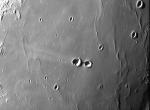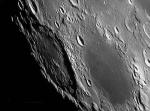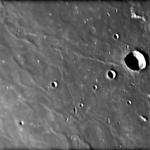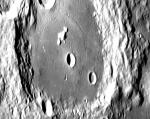|
 A Rille, No Rim and a Rain of Ejecta
A Rille, No Rim and a Rain of Ejecta
14.10.2004 | Lunnoe foto dnya
North of Mare Imbrium, towards the lunar north pole, is a region considerably different than the southern pole. Instead of towering mountains and deep craters, the topography of the region poleward of 60 degrees N latitude is battered and muted with only an occasional younger crater to attract attention. What happened?
 Gasping at Gassendi
Gasping at Gassendi
13.10.2004 | Lunnoe foto dnya
Perhaps Bruno Daversin is not the only one with a personal spaceship. Here is another image that looks more like it came from lunar orbit than an amateur's backyard. Gassendi is an observer's delight and often an imager's despair.
 Polar Dryness
Polar Dryness
12.10.2004 | Lunnoe foto dnya
The lunar south polar region almost always presents a craggy wilderness of rims and peaks, all squeezed together by foreshortening and exaggerated by grazing lighting. Its a delightful place to observe and maybe someday to visit.
 Fertility Central
Fertility Central
11.10.2004 | Lunnoe foto dnya
Can you imagine an image of the central part of Mare Fecunditatis where Messier is not the most fascinating feature? Here is one! (But, yes, this fantastic image does show the rarely imaged N-S butterfly wing pattern of ejecta at Messier).
 Professor and Student
Professor and Student
10.10.2004 | Lunnoe foto dnya
Giovanni Baptista Riccioli was a 17th century Jesuit scientist who devised the system of names still used on the Moon. His nomenclature was displayed on a map constructed by his former student Francesco Maria Grimaldi.
 Marginal Maria
Marginal Maria
9.10.2004 | Lunnoe foto dnya
East of Crisium, when the lighting is right and libration favorable, the limb is dark and smooth with the odd mare called Marginis. This is a very appropriate name, for this patch of dark...
 What a Difference a Day Makes
What a Difference a Day Makes
8.10.2004 | Lunnoe foto dnya
One of the most common - and in a way, most exciting - things you can observe on the Moon is the shifting of shadows as the sun rises over each crater and mountain.
 Diamondback Rille
Diamondback Rille
7.10.2004 | Lunnoe foto dnya
The lunar maria contain many sinuous rilles. All are somewhat difficult to see, and many are best known from orbital photography. One such feature is Diamondback Rille, an informal, astronaut-named guidepost on the approach to the Apollo 11 landing site in southern Mare Tranquillitatis.
 Cleomedes Unveiled
Cleomedes Unveiled
6.10.2004 | Lunnoe foto dnya
Spaceship Daversin has just returned from another Moon mission with the best images in existence of Cleomedes crater. This view shows many features unknown to lunar science. Congratulations, Bruno! This is the clearest view ever of the two known rilles that meet east of the 550 m high off-center peak, Alpha.
 Finding Your Way on a Very Young Moon
Finding Your Way on a Very Young Moon
5.10.2004 | Lunnoe foto dnya
Observing the Moon when its is only 1 to 3 days old is difficult. It's always low in the western sky, lying on it's side, often tremulous with seeing, and such a slim sliver that few features can be identified.

